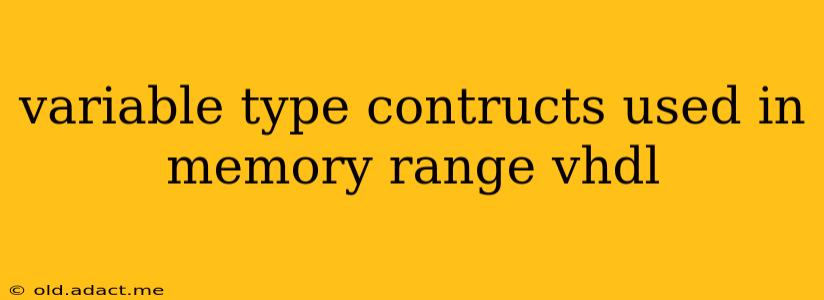Variable Type Constructs Used in Memory Range VHDL
VHDL (VHSIC Hardware Description Language) offers several ways to declare and utilize variables within a specified memory range. Understanding these constructs is crucial for efficient and accurate hardware design. This article explores the various variable type constructs and their applications in defining and manipulating memory ranges within VHDL code. We'll also address common questions surrounding memory management in VHDL.
What are the different ways to declare memory in VHDL?
VHDL primarily uses arrays and records to represent memory. The choice depends on the complexity and organization of your memory structure.
- Arrays: Arrays are the most straightforward way to represent memory in VHDL. They are ordered collections of elements of the same type. You can declare a 1D array representing a simple memory block or a multi-dimensional array for more complex memory structures (e.g., a matrix).
type mem_type is array (0 to 1023) of std_logic_vector(7 downto 0); -- 1KB memory of 8-bit words
signal my_memory : mem_type;
- Records: Records allow you to group elements of different data types together. This is beneficial when you need to associate metadata with your memory locations (e.g., address, validity bit, data).
type mem_entry is record
address : integer range 0 to 1023;
data : std_logic_vector(7 downto 0);
valid : boolean;
end record;
type memory_type is array (0 to 1023) of mem_entry;
signal my_structured_memory : memory_type;
How do I access specific memory locations?
Accessing specific memory locations involves using the array index. Remember that VHDL indexing is typically zero-based.
-- Accessing the 10th element in a simple memory array
my_memory(10) <= x"AA"; -- Assign hexadecimal value AA to the 10th location
-- Accessing data and validity in structured memory
if my_structured_memory(50).valid then
-- Process data if the entry is valid
process_data(my_structured_memory(50).data);
end if;
What are the different data types suitable for memory in VHDL?
The choice of data type depends on the application. Common types include:
- std_logic_vector: For representing binary data. This is widely used for general-purpose memory.
- integer: For representing integer values.
- real: For representing floating-point numbers (though less common in hardware implementations due to resource requirements).
- enumerated types: User-defined types with a set of named values. Useful for representing states or other symbolic data.
- bit_vector: Similar to
std_logic_vectorbut with slightly different properties.
Can I use dynamic memory allocation in VHDL?
Unlike software languages like C or C++, VHDL doesn't directly support dynamic memory allocation at runtime. The size of your memory is fixed during compilation. This is because hardware resources are allocated during synthesis, requiring a static memory size.
How can I initialize memory in VHDL?
You can initialize memory during declaration using aggregate values. This sets the initial state of your memory.
signal my_memory : mem_type := (others => x"00"); -- Initialize all locations to 0
Alternatively, you can initialize specific memory locations individually within a process.
How to handle memory overflow or out-of-bounds access?
VHDL doesn't automatically handle out-of-bounds array accesses; it's crucial to add checks to prevent such errors. Failing to do so might lead to unpredictable behavior or synthesis issues.
if address >= 0 and address < my_memory'length then
my_memory(address) <= new_data;
else
-- Handle out-of-bounds access, e.g., raise an exception or log an error
end if;
What are some common memory-related design considerations in VHDL?
- Memory Size: Carefully consider the required memory size. Larger memories consume more resources.
- Memory Type: Choose the appropriate memory type (RAM, ROM, etc.) based on your application's needs (read/write capabilities).
- Data Width: Select the optimal data width based on the data being stored.
- Addressing: Implement efficient addressing schemes to minimize access time.
By understanding these variable type constructs and best practices, you can effectively design and implement memory management in your VHDL projects, ensuring efficient and reliable hardware designs. Remember to always perform thorough testing and verification to avoid errors and unexpected behavior.
